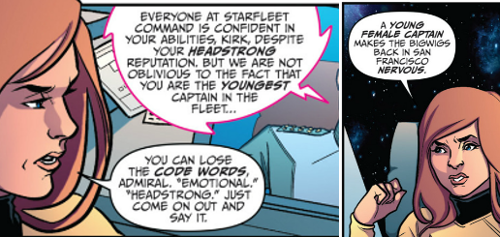IDW Publishing’s Star Trek comics follow the adventures of the Enterprise crew as they explore strange new worlds, seek out new life and new civilizations, and boldly go where no one has gone before.
In Star Trek #29, the Enterprise continues its five-year mission under the command of Jane Tiberia Kirk.
Yup, that’s right:
The fun doesn’t end there: the entire crew, from Lea “Bones” McCoy on down to Hikari Sulu and Pavlovna Chekov, is gender-swapped. (Spock is apparently a gender-neutral name among Vulcans).
Mainstream comics have a well-earned reputation for epic fail when it comes to gender, so when I saw pages of this comic on Racebending’s Tumblr, I had a dual reaction. On the one hand, shut up and take my money. On the other: I hope this isn’t a foul mess.
I grabbed a digital copy from the publisher, and I’m happy to report that is not, in fact, a foul mess. With one glaring exception, the characters have kept the sensibilities and interpersonal dynamics of their better-known counterparts. Captain Kirk is still full of bravado, Bones is still a curmudgeon, and Spock is still Kirk’s good sense. No one’s been turned into a whiny damsel, and artist Yasmin Liang hasn’t drawn our intrepid heroes straining their backs to present their breasts and butt to a viewer they can’t perceive.
Because the characters are still so very much who they are in the normal timeline, the comic gives us a glimpse into a mirror universe I’d sure like to visit: one where a group of brilliant female cadets were given control of a top-of-the-line star ship after stopping a Romulan terrorist when no one else could. Where women can discuss engineering, theoretical physics, and the Prime Directive as readily as they talk about babies. Where Captain Jane T. Kirk’s “love ’em and leave ’em” approach to sex isn’t any more of a mark against her character than it is against Jim’s.
It’s a universe where Jane, like Jim, is free to be driven not by romantic prospects or the need to prove that she’s as good as any man out there, but by the desire to live up to her mother’s legacy–to be worthy of Georgina Kirk’s valiant sacrifice aboard the USS Kelvin.
But while the story is giving these women room to be whole people, it’s also not glossing over the way gendered expectations hit Jane differently than they do Jim. Where Pike pegged Jim’s tenacity and passion as leadership qualities, Jane is instead ‘headstrong’ and ’emotional’–and catches flak for it from her superiors.

This fool just called Captain Kirk ’emotional’ in front of the entire bridge crew. Apparently she’s not emotional enough to flip him the bird he so richly deserves for that.
One thing about the comic did give me pause: Lt. Nnamdi Uhuro. While everyone else is essentially the same person they are in the main timeline, the gender swap seems to have deprived the lieutenant of every ounce of his good sense:

I’m pretty sure that if the real Uhura heard a dude talking like that, she’d roll her eyes in twelve languages.
It isn’t just that this is out of character for Uhura, who would never brook this kind of nonsense. Uhuro is the only man of color with a speaking part in this comic. Giving him the fail-ball here has some unfortunate implications.
I’m also a bit sad about not having the real Uhura around because she holds a special place in pop culture history. Most folks have heard Nichelle Nichols’s story about Martin Luther King, Jr. personally talking her out of quitting Star Trek, and Whoopi Goldberg’s story of how powerful it was for her, as a child, to see Nichelle Nichols in that role: a black woman on TV who wasn’t playing a maid.
People of color remain underrepresented in Star Trek, but in the time since Nichols hung up her communicator, we’ve seen several Black men don the uniform: Sisko as a captain, LaForge as Chief Engineer, Mayweather as a helmsman. If we’re counting aliens, we’ve also got Tuvok and Worf at tactical. But in nearly fifty years of Trek, Uhura is the only black female Starfleet officer we’ve had in a core-cast role. Any mirror universe where she’s not rockin’ her ear-piece is the poorer for it.
And speaking of people of color being underrepresented: this Enterprise is just as white as the original. I wish we’d seen more of Sulu. In this version, she’s the only woman of color in the core cast, and she barely has one line.
But while I wish the ladies of this Enterprise were more diverse, this comic still put a smile on my face. It’s well-written, well-drawn, and funny. Jane Kirk is a great character, and one I wouldn’t mind spending a lot more time with. I’m sad that this is just a two-parter, and not an ongoing series that I can buy every copy of forever.
I’m even sadder that it takes alternate timelines like this for us to get the kind of representation that white men can take for granted. Even white as this mirror-cast is, we’d never see a crew like them on the big screen.
You can get a digital copy of Star Trek #29 directly from the publisher, or pick up a paper copy from your local comic book store.




